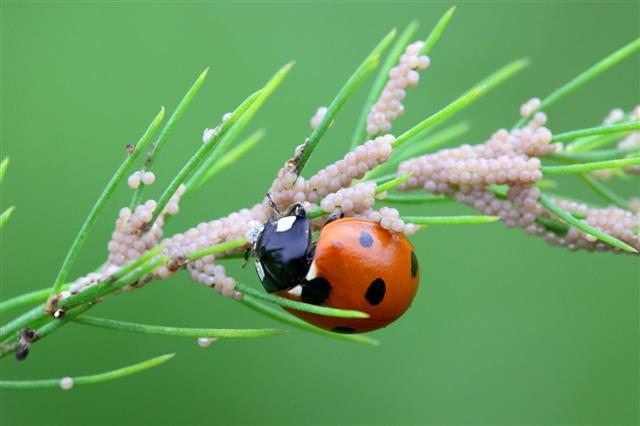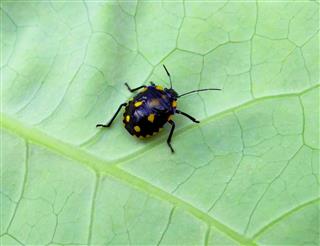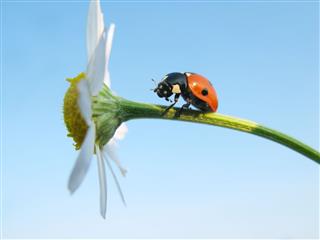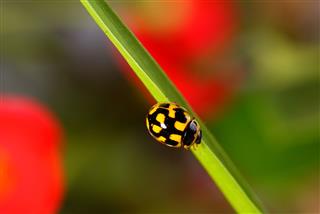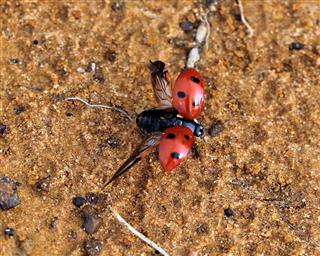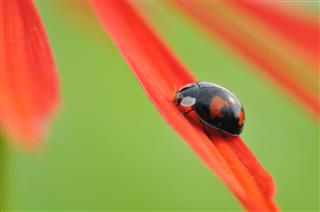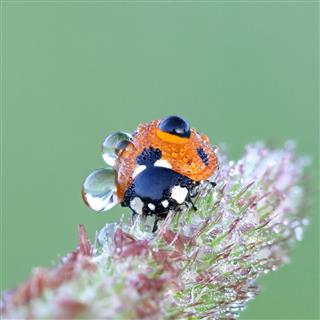
Also known as a gardener’s friend, ladybugs are basically predators. This article provides information on what ladybugs eat, and also some other interesting facts.
The small, red, pretty-looking insects you find in your gardens are ladybugs. Ladybugs belong to the family of beetles and their scientific name is Coccinellidae. The term coccinellidae basically means ‘little red sphere’. They are also called coleoptera, meaning ‘sheath-winged’. The correct term to use for these beetles is ‘lady beetle’. Ladybug is just a slang for lady beetle. The ladybugs or ladybirds are found all over the world and there are about 450 species in America.
Classification
Kingdom: Animalia
Phylum: Arthropoda
Class: Insecta
Order: Coleoptera
Genus: Coccinella
Family: Coccinellidae
You can find ladybugs in a variety of colors apart from the standard red. You can also find yellow, orange, and scarlet-colored ladybugs, with small black spots on their wings. Their legs, head, and antennae are also black in color.
Diet
Kids are often quite curious about what ladybugs eat. Ladybugs are known as the garden helpers and have an omnivorous diet. They have a huge appetite and eat aphids. Their main diet consists of aphids that makes them a favorite bug of farmers and gardeners. Aphids are insects with soft bodies that feed on the plant juices, which leads to plant withering. They are commonly seen on rose plants. Ladybugs begin feeding on aphids the minute their larvae hatch. By the time a ladybug dies, it consumes about 5,000 aphids.
The other bugs that it eats are boll worm, broccoli worm, whitefly, mealybugs, armored scales, pit scales, mites, tomato horn worm, and cabbage moth. They also like to eat eggs of other insects like moths. They enjoy eating pollen and mildew. It is very rare to see a ladybug turning into a cannibal, that is, eating its own kind.
You may even find some species of ladybugs that eat mushrooms and other types of fungus. There are some species that eat leaves and turn into pests instead of being helpful to farmers. However, a majority of them are not considered as pests and are welcome in the garden.
Interesting and Fun Facts
There are over 5000 species of ladybugs on earth, and they are just 1 to 10 mm in size. They are called ladybird beetles in Europe. The Mexican bean beetle and squash beetle species are not garden friends, but pests. They eat the crops of Mexican bean and squash and are termed as destructive pests.
They have bright-colored wings as a measure to ward off predators. They secrete a fluid from the joints in their legs that gives a very foul taste in the mouth of the predator, thus making them a displeasing meal, and predators avoid eating more of them. Many times, a ladybug may play dead and secrete the awful tasting fluid in a bid to save its life. This secretion is called ‘reflex bleeding’, that occurs when the beetle is under stress.
Ladybirds cannot bite humans like mosquitoes or fleas. They pinch their mandibles into the human skin. You won’t even notice the bite when bitten by many species. Its life span is about 3 to 6 weeks. In its short life span, one insect lays up to 1000 eggs. All ladybugs are born black. The larvae take only a week to develop into adults. This also proves that not all ladybugs are females, there are male ladybugs as well, as reproduction is sexual.
Although ladybugs are known for their black spots, there are a few species that are black with red spots. The spots tend to fade as the insect grows old. The pattern of spots, color, and the number of spots help in identifying the species. They beat their wings about 85 times per second while flying. They can chew from side to side.
These insects are cold-blooded and undergo diapause. Insect diapause is similar to animal hibernation. They undergo diapause to conserve their resources and facilitate reproduction. They gather under tree trunks, logs, buildings, etc. When the temperature drops below 55 ºF, they gather heat from the environment and regulate their body temperature. A ladybug can survive diapause for up to 9 months. They come out of diapause when the temperature goes above 55 ºF.
Another interesting fact is that four ladybugs were sent to space on a NASA space shuttle in 1999. This space shuttle was led by Eileen Collins. Ladybugs and aphids were sent into space together to learn how aphids would be able to get away from ladybugs in a zero gravity environment. Scientist wanted to learn how the aphids would manage to jump without gravity. The results showed ladybugs as clear winners. They had managed to eat the aphids and survive in a micro-gravity environment.
These are cute-looking beetles that are a bit mischievous. When the temperatures drop, don’t be surprised to find a ladybug coming into your house as a guest. Ladybugs won’t harm your furniture and fabrics. The next time you spot the ‘lady in red’ in your garden, thank her for helping you protect your plants from pests.







